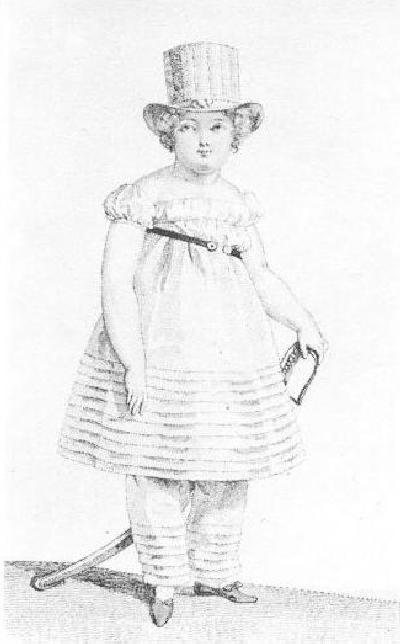
French Boys Clothes: Early 19th Century

Figure 1.--This drawing shows an Empire dress with a low neckline worn by a small French boy in 1816 with pantalettes. A drawing from 1817 shows a girl wearing an almost identical dress and pantalettes. Click on the image to see the girl's dress. The outfit was described as Parisian, "Chapeau de paille, pantalon et robe de perkale." This means, "straw hat, pantalettes and dress of percale."
|
France became an Empire when Napoleon had himself crowned (1804). Thus the Directorate era evolved in to the Empire. The fashion shift here, however, was not major. The new French Empire continued the classical look of antiquity and Directoire fashions. There was a small change, however, the inspiration was no longer te Ronman Republic, but now the Roman Empire. This did notsignificantly affect many garments at forst. Shoprt sleeves, low neclines and hems were still stylish. Decoration was, however, was affected. Direcorate fashions had been dramtically simple-emphasizing a democratic fashion. Empire fashions became more decorative, some ight call "imperially pompous". The light fabrics often in white were gradually replaced by heavier and stiffer materials ones commonly in bright colors. The light unadorned white Directorate dresses were repklaced with velvet dresses, often with elaborate embroidery.
French children wore Directory styles clothes for the first decades of the 19th century. Younger boys wore classic Empire dresses, many with low neck lines. White was a popular color. Dresses were commonly worn with pantalletes. All through the Napoleonic period boys commonly wore skeleton suits, a popular style for boys throughout western Europe and America. Boys also commonly wore tunics, although we have only limited informaion on early tunics. Beginning in the early 1820s a new stiffnes appeared in fashion, in reaction to the fluiity and comfort of Directorate fashions. Women's gowns became much stiffer, adopting the styles of the late Regency shape. Floor length gowns evolved into shorter skirts with a cone-like A-shape. Major changes appeared in necklines and sleeves. The low Directorate necklines moved up. Dresses appeared with long sleeves down to the wrist. Voluminous sleeves appeared at the shoulder. Men's fashions showed some similar changes. Men's collars became much stiffer and higher--this oprobably an infkluence of the military styles of te Napolonic Wars. The top hat appeared for men in the 1820s. It was one of the firsr fashion impoprts from America. Boys wore quite a diverse range of cap and hat styles. Boys wre affected by this increasing stiffness in fashion. The often fancy, but commforatable open style of collars was replaced by closed callers, in some cases the high collars worn by soldiers. We are not sure to what extent some important French styles like smocks and berets were worn during this period. We have not noticed images of boys wearing them, but our information on this period is still very limited. One reason we know less about the early than the mid and late 19th century is that photography only appeared in the 1840s. While France was a leader in the early development of photography, there are only a few surviving images from the the 1830s. Photography was very expensive and studios had just begun to appear.
Christopher Wagner

Navigate the Boys' Historical Clothing Web Site:
[Introduction]
[Activities]
[Biographies]
[Chronology]
[Clothing styles]
[Countries]
[Topics]
[Bibliographies]
[Contributions]
[FAQs]
[Glossaries]
[Satellite sites]
[Tools]
[Boys' Clothing Home]
Navigate the Boys' Historical Clothing French pages:
[Return to the Main French 19th century chronology page]
[Return to the Main French chronology page]
[Return to the Main French page]
[French art]
[French catalogs]
[Difficult French images]
[French choirs]
[French ethnics]
[French movies]
[French postcards]
[French royalty]
[French sailor suits]
[French school uniforms]
[French school smocks]
[French youth grouop uniforms]
Created: November 11, 2001
Last updated: September 12, 2002



